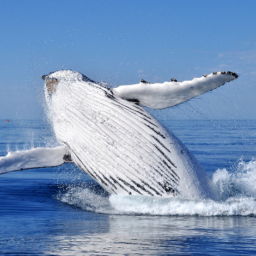All around the skiff, the blue waters of the Atlantic spread out towards the horizon. The azure mirroring of sea and sky is broken only by the silhouette of the mother ship behind us and by the arching black back of the humpback whale, breaking the surface just 150 feet in front of us. At such close quarters the whale is huge, her great girth creating a white wake as she rolls leisurely through the water. While the briefest glimpse of her back and disproportionately small dorsal fin are enough to establish her leviathan status, the pale glint of gleaming white pectorals beneath the surface remind us that what we’re seeing is just a small fraction of the whole animal. To truly comprehend the sheer size and mesmerizing beauty of this creature, we must get into the water. Awaiting the guide’s signal to slip over the side of the small Zodiac, I feel the pull of nerves in the base of my stomach — after all, I’m preparing to keep company with one of the largest creatures on Earth. Suddenly, my uniform of thin wetsuit, fins, mask and snorkel seems a little insufficient for what I’m about to do, and yet, before I know it, I’ve slipped into the whale’s realm.
The sea as it seeps through to my skin feels warm, although I barely notice it as the spectacle before me pushes everything else from my mind. The whale is not alone, as I’d thought on the surface: like a pearl hidden inside an oyster, there is a tiny, milky white calf tucked into this female humpback’s flank. Suddenly seeing them like this is like witnessing the revelation of a magician’s flourished cape. These whales are unafraid of our group, taking little more than a mild interest in such odd intruders to their watery kingdom. They roll and rock gently in the swell just beneath the surface, their impossibly long pectorals languidly revolving now and then to keep them in place.
There are very few people fortunate enough to see eye-to-eye with a whale, and those who do speak invariably of a strange communion, an impression of great wisdom and serenity imparted from one mammal to another. One of the few places where it’s possible to experience this sensation is in the waters off the Dominican Republic. Seventy miles north of the island itself lies the Silver Bank, an area of ocean, 20 miles wide, which hosts an annual gathering of humpbacks every year between January and April. The whales use the warm, clear waters of the Silver Bank as a mating and birthing ground, which explains why so many of the encounters here involve either mother and calf pairs, or male whales vying for a female’s attention. The whales stay just long enough for their calves to gain the strength to swim north, and then leave in search of colder, more productive waters. During their brief time in the DR, a few charters offer itineraries enabling visitors to view the gentle giants, although only some of the humpback interactions are suitable for in-water viewing. Docile mothers and calves, for example, are often happy to tolerate snorkelers, whereas the violent paternity race that sees five or six boisterous male whales in pursuit of a single female is best viewed from the safety of the ship.
Diving with whales is not permitted in the Silver Bank Marine Sanctuary in case the whales see the bubbles as a threat; all in-water encounters take place on snorkel. Whale-watching charters are required to obey strict regulations to ensure that the humpbacks are not disturbed by human activity in the area, and all encounters should be conducted with the utmost respect. In this way, the sanctity of the experience is preserved, with the whales remaining exactly as they should be — wild creatures with the freedom to choose whether or not to grant us the privilege of an insight into their lives.


